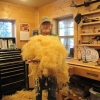Most traditional carving is done on boards, single, glued up - whatever - rather than the tree as a whole.
In this brief overview, I'll describe some ways a carver can convert a piece of 'tree' into useable material.

| 27 August 2020 14:10
Many thanks, Chris. I am so pleased to have received your excellent and clear advice. You have no doubt saved me from a big disappointment. I shall get to it!
Best regards
Mike

| 26 August 2020 17:09
Mike - The one thing you can't do is leave the limewood as a whole section of tree trunk; it will split uncontrollably and you will lose a lot of decent timber.
Here's what I have done with similar logs I have been given:
1. Cut the log in half lengthwise. Cut one of those halves into two; you now have two quarters of the log that you can use for carving in the round. They should lose water with minimal splitting.
2. Cut the remaining half into boards, 1 or 2" thick, for relief carving, say.
3. Seal all the ends with emulsion/acrylic paint or wood glue, to slow the loss of water from them.
4. Store everything in a cool, dry place with plenty of air circulating around.
5. And wait...
Lime seasons quite quickly but the rule of thumb is a year for each inch of thickness.
Best of luck!

| 25 August 2020 18:11
Chris & Carrie, thanks for your continued supply of excellent videos - my daughter has also recently signed up and is loving the site.
I have been lucky enough to have been given some lime wood (from a tree felled about 3 months ago) in the form of 18" diameter trunk sections, approx 18" in length. They are currently stored in a couple of stacks, just inside an open-fronted barn and I am wondering what I should do with them and when to ensure I get the most use out of them. Should I cut them into blanks/blocks now or store them as they are (maybe with separator strips to allow air to circulate) until I am ready to start carving? Any advice you can offer would be very much appreciated.
Many thanks, Mike Wagg.

| 21 May 2018 16:06
Edward - I doubt that Cedar is a good wood for carving in log form; it's very straight grained and I imagine it's very likely to split badly. Having said that, I really have no experience of Cedar as anything other than seasoned boards. Then again, it's a big tree and if you have a log split down the middle, you may be able to carve a half without much splitting.
Elm? That I do know can work as a log without splitting. Its grain tends to be interlocking like Yew and thus less likely to split.
It's this sort of hazardous question that make me glue up seasoned wood!

| 20 May 2018 18:14
Thanks Chris for the great videos. U have given me the will to carry on with carving...
Tell me Chris, are Cedar or Elm ok woods for carving?.
Thanks again
Edward Thomas

| 07 June 2016 12:02
Chris-
Thank you for the helpful reply. Looking forward to using that tree.

| 07 June 2016 07:55
Marshall - Thanks for the kind words!
The sapwood is on the outside of the tree, so look at the end-grain ring structure, as above, for which edge of the board is furthest out. Almost always, the sapwood looks different - usually a lighter colour - and that is mostly undesirable. The sapwood can often be 'punky', cork-like, too and will tend to crumble rather than carve. However, the best test of all is to put your carving tool to it. Colour to one side, some sapwood maintains it's integrity and is quite carveable (eg Yew). I'm afraid I don't know Am. Sycamore but I'd do the same test. Sometimes you need to include it to get the width of board.
Seasoning: Rule of thumb for air drying is 1 year for every inch of board thickness. Seal the ends with emulsion paint, wax, anything really. Stack your boards flat, with sticks in between to allow for air circulation, in a cool, dry place. It's that simple really. I'm sure you'll find lots more advice online.
How wonderful to turn beautiful tree into beautiful objects!

| 06 June 2016 20:47
Chris-
First I wanted to thank you and Carrie for all you do for this site. I watched the Solar Green Man series and was wondering if there is a way to tell if a log has sapwood in it. I have an American Sycamore tree that I wanted to turn into timber. The tree has been dead for quite some time, so would there still be sapwood in it? Also, what process is there to seasoning a piece of wood? Where and how should the wood be dried, and for how long?
Many Thanks!

| 09 November 2013 16:10
Ann - It's not the bark as such that will damage your tools so much as the nail, grit or dirt that you have a very good chance of meeting. If you are going to do a lot of bark removal, I'd keep one brave gouge - perhaps a broad #4 or 5 - for just such suicide missions. It won't matter if the gouge gets a bit dinged as it's not your finished surface, so you needn't worry about it being a perfect edge - like your other tools...

| 09 November 2013 08:58
Chris, not having a lot of special or power tools, is there any orientation or warning that you can give to how best and fastest to clear off the bark of a piece of seasoned wood? Will using my large gouges damage or dull them? Thanks as always!

| 17 June 2013 15:46
Hi all It used to be common practice if carving large 'in the rounds' to hollow out the log to a greater or lesser extent before drying. However, it rarely gives a long term stable timber that does not at some point crack. The best way is to slice the log into reasonable planks and place it in stick somewhere where plenty of air can circulate through the stack. Allow at least one year per inch of thickness and turn the stack at least every six months. That is the planks on the bottom go to the top and the inside planks come to the outside. If you have a good bandsaw you can slice through and through or quarter saw, which is actually the best way to achieve stable timber but not always the best grain pattern. I've been drying timber in this fashion for over forty years and have never yet sealed the ends of the planks. I accept that there will be some end shakes that are cut away, but, to be honest, if allowed to dry slowly and not in direct sun or rain I have rarely had to scrap many boards. Usually they can be used as narrower boards anyhow. If you are after a large bole to carve then simply make as perfect a joint as you can and glue them up.
I average around two or three cubic metres per month, but, have to admit I'm slowing down now.
Pete the wood servant

| 06 March 2013 18:49
Dean - Slicing across the centre of a tree, or branch, is always risky. So risky, I've never done it; so really can't advise on that . (Except, perhaps, 'Don't do it!. Or look into using PEG.') For quartering or other slices, the rule of thumb is to dry for a year for every inch of thickness. And, yes, sealing the ends with wax, or a good coat of acrylic emulsion paint, will help minimise splitting at the ends. Microwaving with wax I've never heard of before. Wax is quite flammable so I think this is an idea to treat with a lot of caution!

| 03 March 2013 16:12
Hi Chris. I was given a lot of newly cut oak branches. Some thin, some sort of arm thickness. I was going to cut thin slices as coasters or tealight holders and use the rest as general carving wood. How would I dry thin slices without cutting through the centre? How long would you need to leave wood that you have cut in half or quarters as you do in your videos and would you need to apply wax to any of it or just leave it to shrink? Lastly, iv heard that you can seal the ends with wax then microwave for a few seconds and weigh it, then microwave... So on until the weights remains the same. Have you tried this? does it work? So many questions! Sorry lol

| 12 December 2012 15:33
There are few trees you can carve as a whole without serious, detracting, splitting and to my knowledge Walnut is not one of them. If it were my log and I'd plans to use it for work in the round. I'd cut it lengthwise in half and then cut one of those pieces in quarters; sealing all the ends and leaving to season. You will end up with wood for smaller carvings than the whole of course but they would still be reasonable size for the width. It's for this reason we glue up wood to get bulk. For relief work I'd saw it through and through into 2" boards; seal and season. I've never used PEG type products, of which I assume Pentacryl is one, so can't help you there.

| 12 December 2012 15:16
Alright Chris, went and found a tree as you suggested, boy did I find a tree. I am now the proud, if a little intimidated, owner of a huge Black Walnut log (24" across by 12' long). Other than sealing the ends of it I really don't have a clear idea on which direction I should go to start seasoning it. Your books have several suggestions as does your video. I might chance some green carving with the help of Pentacryl, but there is so much timber that I'm unsure the best way to proceed. I'd like to just air dry it, but at this size I might be dead before it dried completely. Any suggestions?
Thanks ,Guy
--

| 29 November 2011 08:23
Guy - I've rarely carved un-seasoned ('green') wood. In my sort of work I cannot afford uncontrolled splits. Air-dried is much milder than kiln-dried and that's my preference. I've always carved European Oak, which is a wonderful wood suited to strong simple designs, so cannot speak to other species. The best thing is to find other woodcarvers locally and see where they get their wood, what they use, and for what etc. Go find the trees - you don't have to hug them! Make it a bit of a study?

| 29 November 2011 08:17
Eric - It does indeed vary but if you look at the end of your log and it's full of splits then you are already too late. Still, you might saw it up and you may find the middle section is still shake free and usable. The tall figure that Carrie carved in the 'Working with the Grain' video, she pulled out of the sea! You can carve any wood I've heard it said, except rhubarb. Hose and brush the crud off well and just be prepared to re-sharpen until you get into good wood below.

| 27 November 2011 21:42
Chris,
I had a question about wood maybe you could answer. I've just relocated and I am having a challenge finding good sources of carving wood. There is a lot of Oak in this area, specially Live Oak, I've never craved in it and wondered if you had any experience with it, I believe you have referenced it (oak) in your books and maybe in one of the project videos. Just curious as to how it might crave and what type of carvings it would be best suited for. Of course English Oak might be a totally different case than what I have available.
Thanks, Guy

| 16 April 2011 12:41
I imagine it varies with the type of wood, but what is a reasonable amount of time that one has between falling a tree and sawing for drying before it is "too late" to salvage the wood?
Can wood be salvaged from drift wood from the ocean or is that a bad idea because of the dirt and sand?